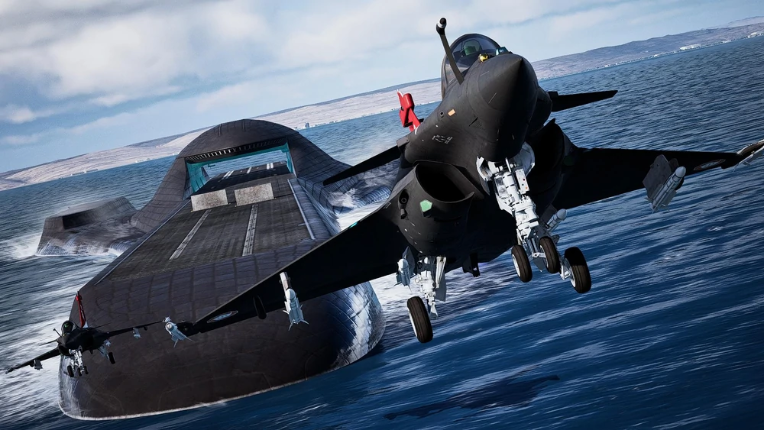Alright I’m going to do this now. The alicorn in ace combat 7 *WARNING SPOILERS DEAD AHEAD IF YOU HAD NOT PLAYED THE DLCS*
heres a image of it
the super carrier cruiser Alicron is a submarine aircraft carrier
it can carry to a list of aircraft
- 20 Su-33 Flanker-Ds
- 22 F/A-18F Super Hornets
- 24 MiG-29Ks
- 30 Rafale Ms
Weaponry
Unlike a conventional submarine, the Alicorn was intended to operate not as a traditional strategic missile submarine, but instead as a "submersible aviation cruiser" - an underwater missile cruiser with the ability to conduct aircraft carrier operations. As such, it mainly relied on guns, missiles, and its aircraft.[12]
The Alicorn carried heavy anti-air armaments along the length of the boat, including CIWSemplacements, ,and surface-to-air missile launchers that were deployed from hatches within the hull. Upon submerging, these weapons retracted into the hull, followed by the hatch closing up.
*the links are in AC*
24 VLS tubes were placed within both auxiliary hulls, for a total of 48 launchers. They supported various short-range anti-air and anti-ship missiles, along with long-range submarine-launched ballistic missiles. At one point, it was reported by the public media that the Alicorn was a "doomsday ship" with 256 SLBM tubes, each capable of launching missiles equipped with 200 kt nuclear warheads,but this was proven to be false reporting.
The Alicorn featured two gun bays, one on each auxillary hull, ahead of the VLS launchers. FRONT LINE's article in April 2012 assumed these bays carried conventional naval rifles, but the OIA's report 12 years prior indicated that based on the materials taken to its construction site, the Alicorn likely "[carried] railguns as its main guns". At the time of the Lighthouse War, each gun bay carried one large railgun turret, each with the ability to fire up to 80 rounds per minute. The sabot in each railgun was 200 mm with a barrel length of 6.5 m (33 caliber) and the capacity to support 155 mm projectiles, guided by GPS/INS. The projectiles ranged from Armor-Piercing Composite Rigid (APCR) shells to High-Explosive Anti-Ship (HEAS) shells. The turrets could rotate a full 360 degrees and pivot upward, allowing for them to target aircraft.
the story of the Alicorn
Following the completion of the Scinfaxi-class submersible carriers, Yuktobania initiated "Проект Аликорн" ("Project Alicorn") in 1998 to create a third, larger submarine - dubbed unofficially by the Osean Intelligence Agency as a "Super Scinfaxi-class" submarine - that combined the capabilities of the Scinfaxi and Hrimfaxi into one package. The OIA's Advanced Weapons Analysis division observed sand carriers actively excavating underneath Okchabursk in 1999. The underground facility beneath the city already housed two 400-metre (1,300 ft) docks to repair and maintain the Scinfaxi-class boats, but the sand carriers were still excavating an estimated 1,000 cubic metres of sand every day.
The OIA suspected that, within a year, Yuktobania completed construction of a new 600–700-metre dock for the new submarine. The OIA observed steel and weapons being delivered to Okchabursk and used them to estimate the Alicorn's capabilities. The Advanced Weapons Analysis division completed its report on the new submarine on March 27, 2000. At one point, the Alicorn and its long-range armaments were reported as a potential violation of the START2 treaty.
The Alicorn's actual construction period is unknown, nor is it confirmed if Yuktobania ever fully finished it. It did not take part in the Circum-Pacific War in 2010 due to a myriad of problems involving its steam-powered catapult valves, and at no point in the conflict did Osean forces approach Okchabursk to threaten it. By 2012, Yuktobania had completed most of the boat's hull.
Launching and groundingErusea did not officially launch the Alicorn until January 1, 2015. Captain Matias Torres was eventually assigned as the submarine's commanding officer; on December 2, 2015, he was assigned as the head of the submarine's pre-commissioning crew. Sometime after, the boat underwent outfitting.
The Alicorn sailed out for a sea trial on October 9, 2016, during which tests to determine the operational limits of the SRC-03a rail cannon were conducted. It accidentally ran aground underwater one month later on November 10. One week later, on November 17, following accusations from Osean media outlets, officials from the Erusean Royal Navy confirmed that the submarine had indeed gone missing, insisting that they "have found no evidence of an explosion, have not determined the submarine to be sunk," and that "no radioactive materials [were] released in the Spring Sea... maritime traffic safety [was not] compromised." The next day, GAZE published an article reporting that the submarine had gone missing in the Spring Sea, 1,300 km (810 mi) south-southeast from the Twinkle Islands, citing the official Erusean statement. Due to the high complexity of the underwater terrain, the submarine was not discovered until two years later, on October 9, 2018. It had remained on the seafloor for 698 days in total, at a fifteen degree tilt. 330 of the 356 crewmembers survived.
AlicornErusean Navyreserve fleetSAC-900AlicornAlicornLighthouse WarAlicornnuclear shellsAlicornNjord Fleetan Osean raid[23]Alicorn




